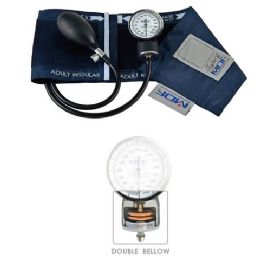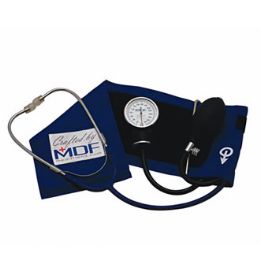













What is a Sphygmomanometer?
A sphygmomanometer is a device used to measure blood pressure. It consists of a cuff placed around the arm, as well as a device to measure the pressure when blood freely flows and when blood flow is restricted. When the device is used, the cuff is inflated normally around the upper arm, and then the pressure is released gradually. A digital sphygmomanometer usually operates at the touch of a button and the blood pressure information is displayed on a digital screen. Many manual models are also still in use and normally require a medical professional to correctly operate them.
In a manual device, the pressure is shown as the height of a column of mercury in a tube. As the cuff is inflated manually, the height of the mercury column increases, and as the pressure is released, the height decreases. A medical professional usually listens with a stethoscope to the main artery of the arm while the cuff deflates. When the blood flow begins to flow again after being stopped by the cuff, a pounding or rushing sound begins to be heard through the stethoscope. The pressure at which this occurs is called the systolic pressure. The cuff is allowed to further deflate, and the pressure at which the sound is no longer heard is called the diastolic pressure. These two numbers are recognized as the blood pressure value.
It is important that the blood pressure is taken when a person is relaxed to avoid a falsely elevated reading. Hormones, such as adrenaline, can increase a person’s blood pressure dramatically because they can constrict the blood vessels. For example, a person who has been severely startled will have an elevated blood pressure compared to someone who is watching TV. Accurate readings are critical to determine the health of the heart and the rest of the body. Using a sphygmomanometer can take some practice to ultimately acquire consistent readings. However, for those who need to measure their blood pressure frequently, this may be a valuable skill to learn. Besides being convenient to use at home, some individuals get nervous when a healthcare professional takes their blood pressure, throwing off the reading. Being able to measure one’s own blood pressure at home can be medically relevant and an absolutely crucial component to blood pressure regulation.
What is the Difference Between Systolic and Diastolic Blood Pressure?
Systolic and diastolic blood pressure shows the force of blood on the blood vessel walls as it travels through the body. Both are measured in millimeters of mercury (mmHg), but when written together as a fraction, it is done without listing the mmHg unit of measurement, such as 110/70. The top number of the fraction is the systolic blood pressure, and the bottom number is the diastolic blood pressure. Each measurement occurs at opposite times as the heart beats.
The systolic pressure is the maximum force that is exerted on the blood vessels. It happens as the heart is beating and the left ventricle of the heart contracts, pushing blood into the aorta. This allows the blood to carry nutrients and oxygen throughout the body. In contrast, the diastolic pressure is the minimum force on the blood vessels between heart beats when the heart is relaxed. It is taken just before the ventricle of the heart pushes blood into the aorta, when it is refilling with blood.
A normal blood pressure reading varies slightly in different countries. In the US, normal readings for an adult are 90-120 for systolic pressure and 60-80 for diastolic pressure. In the UK, up to 140 is normal for systolic pressure and up to 90 is normal for diastolic pressure. A person’s blood pressure readings will naturally fluctuate throughout the day due to the body’s circadian rhythm. It will also respond to changes in the body due to disease, exercise, and drugs. It is best to check the blood pressure several times during the day to get an average, rather than relying on just one measurement.
In general, for those over 50 years old, the systolic reading is regarded as more important than the diastolic number for diagnosing different types of cardiovascular diseases. Due to factors such as hardening of the arteries and the buildup of plaque in the blood vessels over time, the systolic pressure will increase steadily with age for most people. Hypertension, or consistently high blood pressure, can lead to heart attacks or organ damage.
What Factors Affect Diastolic Blood Pressure?
The diastolic pressure can go up or down, depending on a number of things. The number may have an overall increase or decrease over time, or changes can be rapid and temporary. Some factors that can affect the diastolic pressure levels in the short term include changes in posture, stress, and exercise. Factors that can cause it to change in the longer term are diet and lifestyle, family history, and overall health. One factor that has a significant negative impact in the short and long term is smoking.
Many situations can make diastolic pressure change fairly rapidly; therefore, taking several readings may be the best way to get a true idea of its level. Readings normally shift throughout the day, going down at night and rising in the morning. Those feeling high levels of anxiety or stress and who are very tense may find their diastolic pressure to be higher than normal. It may also be different than normal when taking a blood pressure measurement just after exercising. Changing posture, such as going from lying down to standing, can cause it to change quickly.
Some factors can cause diastolic pressure levels to go up or down in a more permanent way. Family history is often a very good prediction of blood pressure levels. Those with close relatives who have high or low blood pressure often tend to have similar levels. Lifestyle can also play a big role. For example, those who have an unhealthy diet, are overweight, or obese may tend to have higher diastolic levels. Those who exercise regularly tend to have lower levels. Overall health can also play a role, especially if there are certain issues like heart disease or needing to be on medications that affect blood pressure. Smoking can have a lot to do with diastolic pressure levels, in the short term and the long term. Directly after smoking, the nicotine in the blood can cause a rapid increase in pressure. Over the long term, smokers may be at a greater risk for high blood pressure, with increases in both diastolic and systolic pressure.
Hulet Smith, OT
Rehabmart Co-Founder & CEO
lb